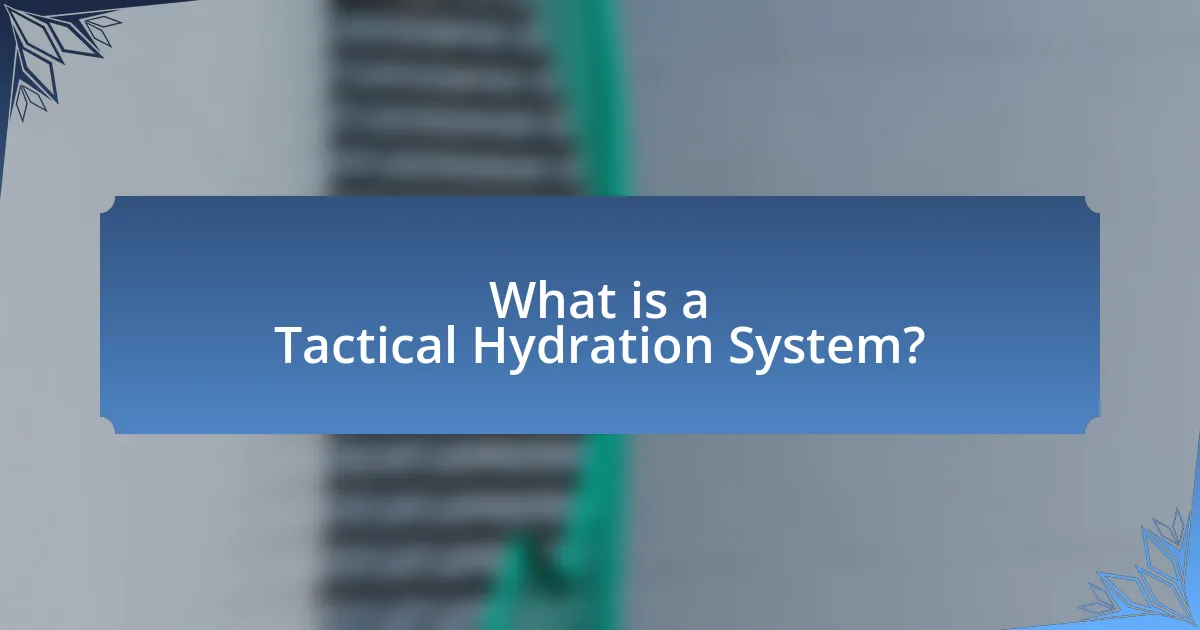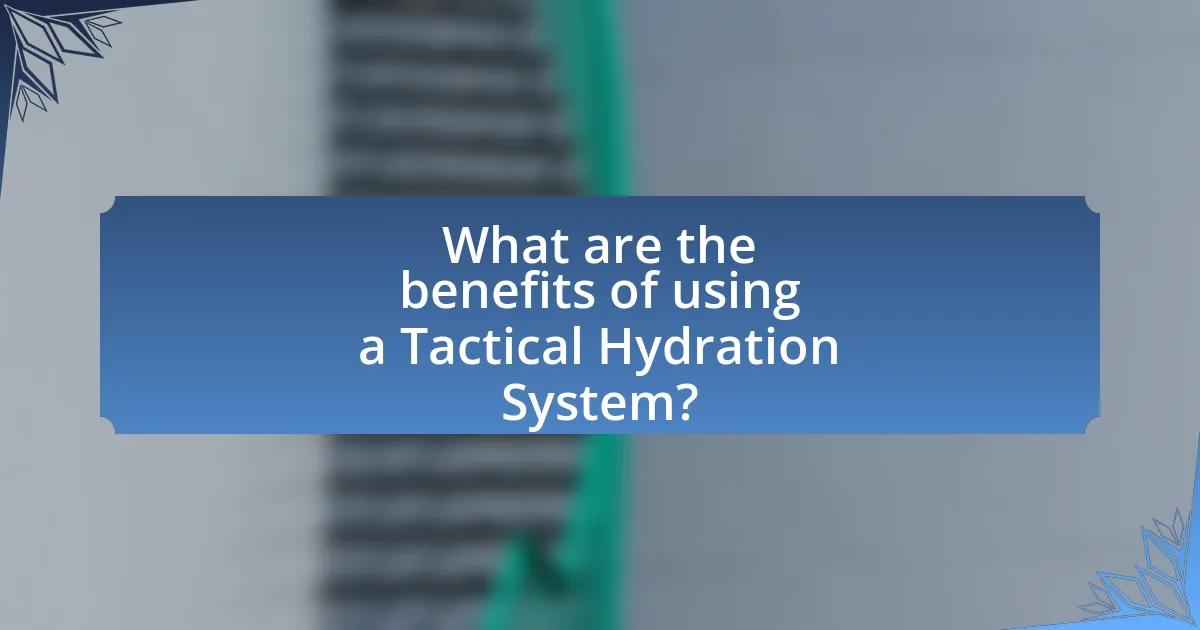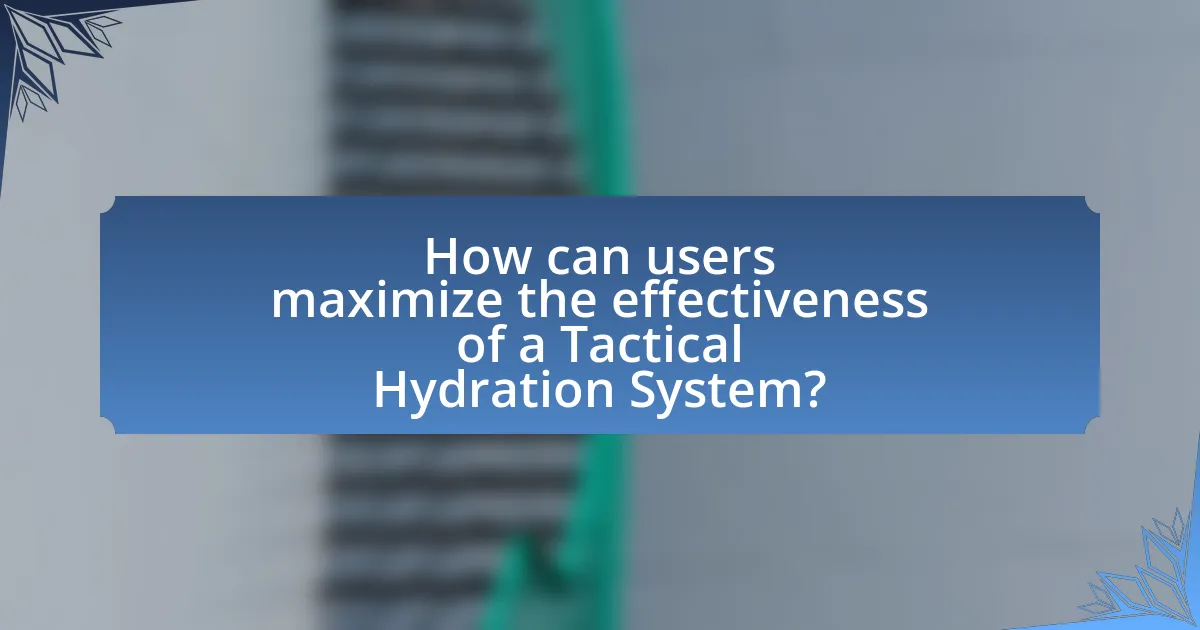A Tactical Hydration System is a specialized water delivery system designed for military, outdoor, and tactical use, enabling efficient hydration while on the move. The article outlines the functionality, key components, and benefits of these systems, emphasizing their importance in maintaining hydration during demanding activities. It discusses how proper hydration enhances physical performance and cognitive function, the risks associated with dehydration, and best practices for using and maintaining these systems. Additionally, the article highlights the advantages of Tactical Hydration Systems over traditional hydration methods, including convenience, portability, and reliability in various environments.

What is a Tactical Hydration System?
A Tactical Hydration System is a specialized water delivery system designed for military, outdoor, and tactical use, enabling users to carry and access water efficiently while on the move. These systems typically include a reservoir or bladder that can be integrated into backpacks or vests, along with a drinking tube for hands-free hydration. The design prioritizes durability and ease of use in demanding environments, often featuring materials that are resistant to punctures and leaks. Tactical Hydration Systems are essential for maintaining hydration during extended activities, as they allow for quick access to water without the need to stop or remove gear.
How does a Tactical Hydration System function?
A Tactical Hydration System functions by providing a convenient and efficient means for individuals to carry and access water during activities such as military operations, hiking, or sports. This system typically consists of a reservoir, often made of durable materials, that holds water and is connected to a drinking tube, allowing users to hydrate without stopping their movement. The design often includes features such as insulation to maintain water temperature and compatibility with backpacks for easy transport. The effectiveness of these systems is supported by their widespread use among military personnel and outdoor enthusiasts, demonstrating their reliability in demanding environments.
What are the key components of a Tactical Hydration System?
The key components of a Tactical Hydration System include a hydration reservoir, a drinking tube, and a bite valve. The hydration reservoir, typically made from durable materials, holds water and is designed to fit in tactical gear such as backpacks or vests. The drinking tube allows for easy access to water without removing the reservoir, facilitating hands-free hydration. The bite valve, which is often equipped with a shut-off mechanism, ensures that water only flows when needed, preventing leaks and spills. These components work together to provide efficient hydration in demanding environments, enhancing performance and endurance for users.
How do these components work together for effective hydration?
The components of a tactical hydration system, including the reservoir, tubing, and bite valve, work together to ensure effective hydration by providing a convenient and efficient means of water delivery. The reservoir holds the water, while the tubing allows for easy access to the liquid without the need to stop or remove gear. The bite valve enables quick sipping, minimizing spillage and maximizing hydration efficiency during physical activities. This design is particularly beneficial in high-intensity situations, as it allows users to maintain hydration without interrupting their performance, which is crucial for endurance and overall effectiveness in tactical scenarios.
Why is hydration important in tactical situations?
Hydration is crucial in tactical situations because it directly impacts physical performance, cognitive function, and overall mission success. In high-stress environments, such as military operations or emergency response scenarios, maintaining adequate fluid levels helps prevent dehydration, which can lead to fatigue, impaired judgment, and decreased coordination. Research indicates that even a 2% loss in body weight due to dehydration can significantly impair physical performance and cognitive abilities, making hydration essential for maintaining operational effectiveness.
What are the risks of dehydration during tactical operations?
Dehydration during tactical operations poses significant risks, including impaired cognitive function, decreased physical performance, and increased susceptibility to heat-related illnesses. Research indicates that even a 2% loss of body weight due to dehydration can lead to a decline in cognitive abilities, affecting decision-making and reaction times, which are critical in high-stakes environments. Additionally, dehydration can reduce endurance and strength, leading to fatigue and increased risk of injury. The U.S. Army’s Field Manual 21-18 emphasizes the importance of maintaining hydration to ensure operational effectiveness and safety, highlighting that soldiers are at a higher risk of heat exhaustion and heat stroke when dehydrated.
How does proper hydration enhance performance in the field?
Proper hydration enhances performance in the field by maintaining optimal physiological function, which is crucial for endurance and cognitive abilities. When individuals are adequately hydrated, their cardiovascular system operates efficiently, allowing for better blood flow and oxygen delivery to muscles, which can improve stamina and reduce fatigue. Research indicates that even a 2% loss in body weight due to dehydration can impair physical performance and cognitive function, leading to decreased reaction times and increased risk of heat-related illnesses. Therefore, maintaining hydration through a tactical hydration system can significantly boost overall effectiveness and safety in field operations.

What are the benefits of using a Tactical Hydration System?
A Tactical Hydration System provides efficient hydration solutions for individuals engaged in demanding activities. These systems typically feature a hands-free design, allowing users to drink water without interrupting their tasks, which is crucial in high-stakes environments. Additionally, they are designed to be lightweight and compact, minimizing the burden on the user while maximizing water storage capacity. The materials used in these systems are often durable and resistant to environmental factors, ensuring reliability in various conditions. Furthermore, many tactical hydration systems include insulation to keep water cool, enhancing the user’s comfort during prolonged use.
How does a Tactical Hydration System improve convenience for users?
A Tactical Hydration System improves convenience for users by allowing hands-free access to water while engaging in activities. This system typically integrates a reservoir and a drinking tube, enabling users to hydrate without stopping or removing their gear. For instance, military personnel and outdoor enthusiasts benefit from this design, as it enhances mobility and efficiency during operations or adventures. The ability to drink water on-the-go reduces the risk of dehydration and allows users to maintain focus on their tasks, thereby increasing overall performance and safety.
What features contribute to the ease of use in a Tactical Hydration System?
The features that contribute to the ease of use in a Tactical Hydration System include a hands-free drinking mechanism, lightweight materials, and adjustable straps. The hands-free drinking mechanism, often facilitated by a bite valve, allows users to hydrate without stopping their activities, enhancing convenience during operations. Lightweight materials reduce the overall burden on the user, making it easier to carry for extended periods. Adjustable straps ensure a secure fit, allowing for quick adjustments based on the user’s body type and gear, which further simplifies the use of the system in various tactical scenarios. These features collectively enhance the functionality and practicality of Tactical Hydration Systems in demanding environments.
How does portability affect the user experience?
Portability significantly enhances the user experience by allowing individuals to easily carry hydration systems during various activities. When a tactical hydration system is lightweight and compact, users can access water conveniently without hindrance, which is crucial during outdoor activities like hiking or military operations. Research indicates that a well-designed portable hydration system can improve hydration rates by up to 30%, as users are more likely to drink water when it is readily accessible. This ease of access not only promotes better hydration but also contributes to overall performance and comfort, making portability a key factor in the effectiveness of tactical hydration systems.
What advantages does a Tactical Hydration System offer over traditional hydration methods?
A Tactical Hydration System offers superior convenience and efficiency compared to traditional hydration methods. These systems typically feature a hands-free design, allowing users to drink water without stopping their activities, which is crucial in high-intensity situations. Additionally, Tactical Hydration Systems often have a larger capacity than standard water bottles, enabling prolonged hydration without the need for frequent refills. They are also designed to be lightweight and easily integrated into tactical gear, enhancing mobility and reducing the burden on the user. Furthermore, many Tactical Hydration Systems are constructed from durable materials that resist punctures and leaks, ensuring reliability in demanding environments.
How does a Tactical Hydration System ensure consistent water access?
A Tactical Hydration System ensures consistent water access by integrating a reservoir with a delivery mechanism, allowing users to drink hands-free while on the move. This design typically includes a flexible bladder that can hold several liters of water, coupled with a tube that delivers water directly to the user’s mouth, minimizing the need to stop and access separate water containers. The systems are often constructed from durable, lightweight materials that withstand harsh conditions, ensuring reliability in various environments. Additionally, many tactical hydration systems feature insulation to keep water cool and prevent freezing, further enhancing their effectiveness in maintaining consistent hydration during extended activities.
What role does a Tactical Hydration System play in weight management for users?
A Tactical Hydration System aids in weight management by ensuring users maintain optimal hydration levels, which can prevent overeating and support metabolic processes. Proper hydration is linked to appetite regulation; studies indicate that dehydration can lead to increased feelings of hunger and cravings for high-calorie foods. Additionally, staying hydrated enhances physical performance, allowing users to engage in more effective workouts, which contributes to weight loss and maintenance. Therefore, the use of a Tactical Hydration System not only facilitates hydration but also supports users in managing their weight effectively.

How can users maximize the effectiveness of a Tactical Hydration System?
Users can maximize the effectiveness of a Tactical Hydration System by ensuring proper maintenance, optimal hydration strategies, and appropriate usage techniques. Regularly cleaning the hydration bladder and tubes prevents bacterial growth, which is crucial for safe drinking. Additionally, users should drink water consistently throughout their activities rather than waiting until they feel thirsty, as this helps maintain hydration levels and enhances performance. Furthermore, utilizing the system’s features, such as bite valves and insulation, effectively keeps water accessible and at a desirable temperature, which encourages more frequent hydration. Studies indicate that maintaining hydration can improve physical performance by up to 20%, underscoring the importance of these practices.
What best practices should users follow when using a Tactical Hydration System?
Users should ensure proper cleaning and maintenance of a Tactical Hydration System to prevent contamination and ensure optimal performance. Regularly rinsing the reservoir with warm water and mild soap, and allowing it to air dry, helps eliminate bacteria and mold growth. Additionally, users should fill the system with clean, potable water and avoid using sugary or flavored drinks, as these can lead to residue buildup and require more intensive cleaning. It is also advisable to check for leaks and inspect the hoses and connections before each use to ensure functionality. Following these practices enhances the longevity and effectiveness of the hydration system, which is crucial for maintaining hydration during tactical operations.
How often should users refill their Tactical Hydration System?
Users should refill their Tactical Hydration System every 2 to 4 hours, depending on activity level and environmental conditions. This frequency ensures adequate hydration during physical exertion, as the human body typically requires about 2 to 3 liters of water per day, and more during intense activities. Maintaining this refill schedule helps prevent dehydration, which can impair performance and lead to health issues.
What maintenance tips are essential for prolonging the life of a Tactical Hydration System?
To prolong the life of a Tactical Hydration System, regular cleaning and proper storage are essential. Cleaning should involve rinsing the reservoir and tube with warm water and mild soap after each use to prevent mold and bacteria buildup. Additionally, using a cleaning kit specifically designed for hydration systems can enhance maintenance by reaching difficult areas. Proper storage requires ensuring the system is completely dry before sealing it to avoid moisture retention, which can lead to degradation of materials. Following these maintenance tips can significantly extend the lifespan of the hydration system, as neglecting them can result in contamination and material wear.
What common issues do users face with Tactical Hydration Systems?
Users commonly face issues with Tactical Hydration Systems such as leaks, difficulty in cleaning, and discomfort during use. Leaks often occur due to faulty seals or damaged hoses, leading to water loss and potential gear damage. Cleaning can be challenging because of narrow openings in reservoirs, which can harbor bacteria if not properly maintained. Additionally, users frequently report discomfort from the weight distribution of the system, especially during prolonged use, which can lead to chafing or back strain. These issues highlight the importance of selecting high-quality systems and maintaining them properly to enhance user experience.
How can users troubleshoot leaks in their Tactical Hydration System?
To troubleshoot leaks in a Tactical Hydration System, users should first inspect all components, including the reservoir, hoses, and connectors, for visible damage or wear. If any cracks or holes are found, replacing the damaged parts is necessary to prevent leaks. Users should also ensure that all connections are securely tightened, as loose fittings can lead to leaks. Additionally, users can perform a water test by filling the system and checking for leaks in a controlled environment. This method allows for easy identification of problem areas. Regular maintenance, such as cleaning and drying the system after each use, can also help prevent leaks by reducing wear and tear.
What steps can be taken to prevent mold and bacteria growth in the system?
To prevent mold and bacteria growth in a tactical hydration system, regular cleaning and maintenance are essential. This involves thoroughly washing the hydration reservoir and tubes with warm, soapy water after each use, ensuring all components are dried completely before storage. Additionally, using a mixture of vinegar and water or a specialized cleaning solution can effectively eliminate any remaining bacteria or mold spores. Research indicates that maintaining a dry environment and avoiding prolonged storage of water in the system significantly reduces microbial growth, as moisture is a key factor in mold and bacteria proliferation.


